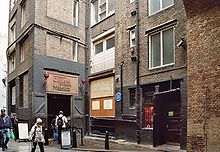- Liberty of the Clink
-
 Blue plaque on the site
Blue plaque on the site
The Liberty of the Clink was an area in Southwark, on the south bank of the River Thames, opposite the City of London. Although situated in Surrey the liberty was exempt from the jurisdiction of the county's high sheriff and was under the jurisdiction of the Bishop of Winchester who was usually either the Chancellor or Treasurer of the King.
The liberty was originally north-eastern part of the 'hide of Southwark' granted by Henry I to the Priory of Bermondsey (later Bermondsey Abbey) in 1104-09 and that house then sold it to the Bishop of Winchester in ca 1149, who wanted a house for his London governmental duties. The Bishopric's administration referred to it as the 'Manor of Southwark' ie the Manor of the Bishop in Southwark. It was also known as the 'Liberty of Winchester'. The liberty (ie a manorial jurisdiction) was confirmed when King Stephen sanctioned the transaction for his brother Henry Blois, then Bishop of Winchester. It was approximately 70 acres (28 hectares) in size and was situated in the modern Bankside area of the London Borough of Southwark. Clink Street and Winchester Street recall the former liberty.
It formed part of the parish of St Margaret's, Southwark until 1539 when it was closed being replaced by St Saviour's (now Southwark Cathedral). As a civic area it was united in the St Saviour's District with St Saviour's and Christchurch, Surrey under the Metropolitan Board of Works from 1855.
The Clink is most famous for its prison. The first recorded use of the term Liberty of the Clink was in 1530; the nickname was used informally to avoid confusion with the other manors in Southwark. 'Clink' seems to be derived from the name of the Bishop's prison, which he held as a civil authority deriving from his role as Chancellor or Treasurer. It was also the manorial gaol maintained by the bishop as part of the administration of the liberty.
The bishop's London residence, Winchester House was built in the liberty, originally surrounded by parkland.
Contents
Illicit activities
The liberty lay outside the jurisdiction of the City of London, and that of the county authorities of Surrey, and activities forbidden in those areas were permitted within it.
Prostitution
In 1161 the bishop was granted the power to licence prostitutes and brothels in the liberty[citation needed]. The prostitutes were known as Winchester Geese, and many are buried in Cross Bones, an unconsecrated graveyard. Similarly, to "be bitten by a Winchester goose" meant "to contract a venereal disease",[1] and "goose bumps" was slang for symptoms of venereal diseases.
Theatres
Theatres and playhouses were allowed in the Clink, the most famous being the Globe Theatre where William Shakespeare performed his plays. Another noted one was The Rose, where Shakespeare and Christopher Marlowe both premiered plays.
Animal baiting
Bull and bear baiting were also permitted.
Abolition
During the period of the Commonwealth the episcopy was abolished, and the liberty was sold to a private owner in 1649. It was returned to the bishop on the restoration in 1660.
The Clink prison was destroyed in 1780, and the bishop's palace in 1814. In 1856 most local government in the area passed to the St Saviour's District Board of Works and the Metropolitan Board of Works. In 1863 the rights of the Bishop of Winchester in the liberty were vested in the Ecclesiastical Commissioners.
The liberty was finally abolished in 1889, when the Local Government Act 1888 merged all remaining liberties into counties. The Liberty of the Clink thus became part of the new County of London.
Notes
External links
- The borough of Southwark manors, from the Victoria County History of Surrey
Categories:- History of Southwark
- Liberties of London
Wikimedia Foundation. 2010.

